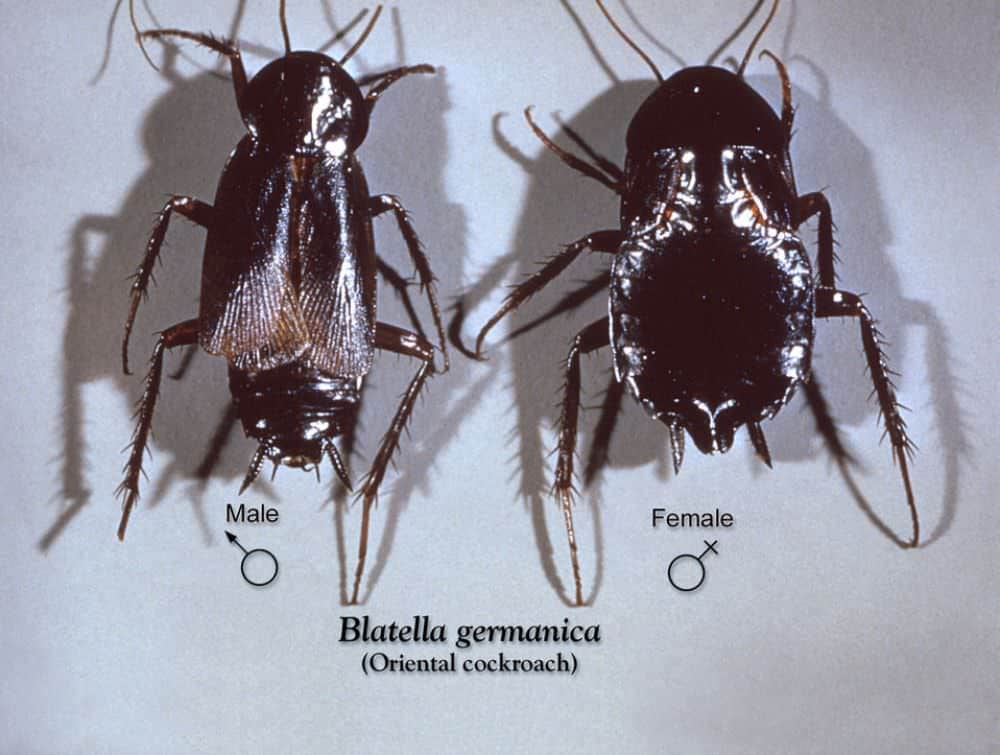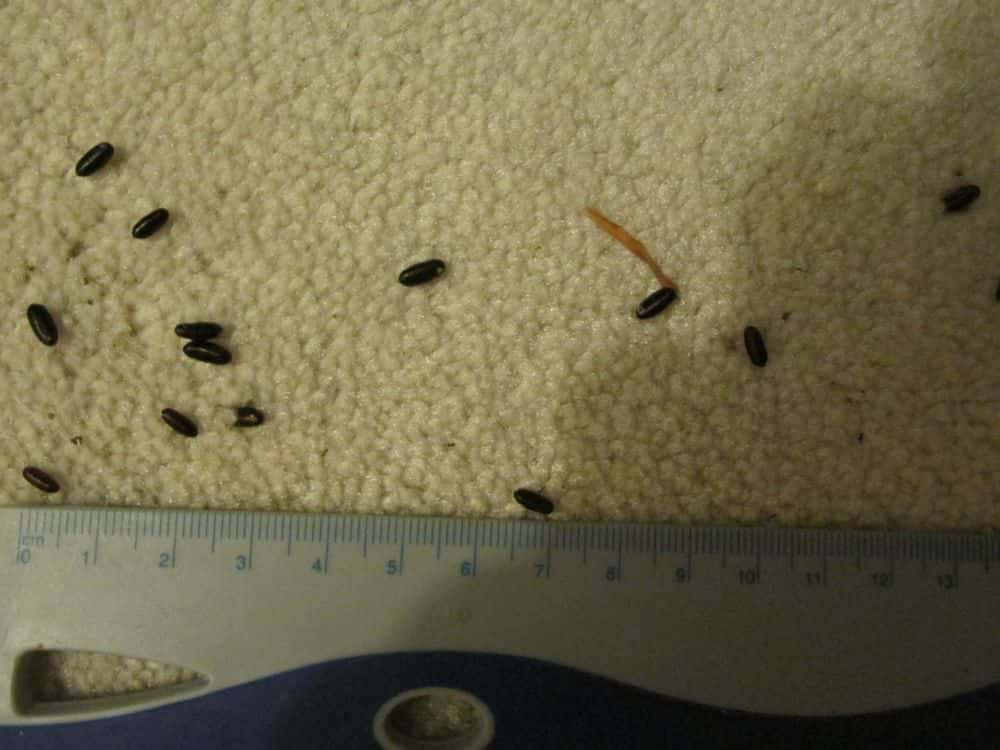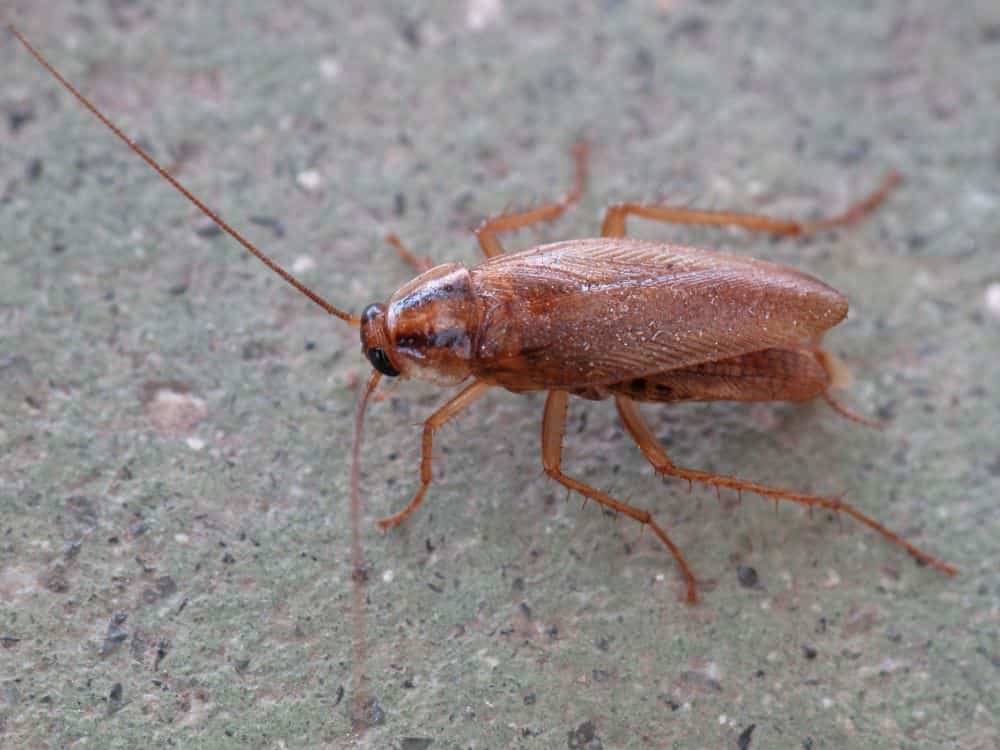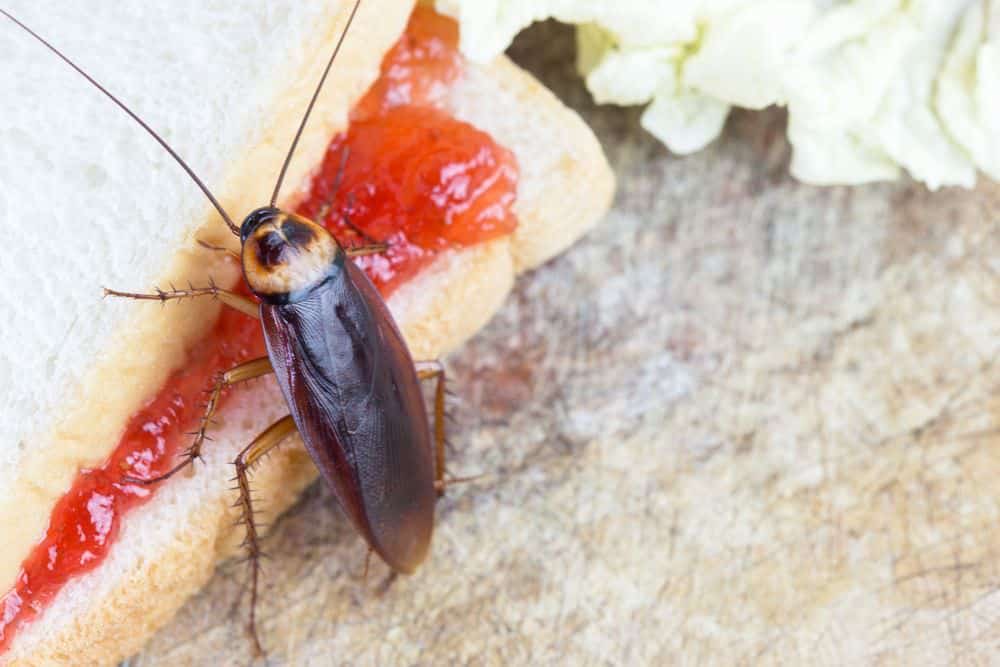Baby Roaches: Everything You Need To Know
Baby cockroaches are an indication of a serious infestation. For this reason, it’s important to be able to identify them. In this article, you will learn how to differentiate between baby cockroaches and adults.
You will also discover how roaches progress from babies to adulthood, and if the babies bite. Finally, I have detailed effective strategies to kill roaches at this stage of life.
What Do Baby Roaches Look Like?
Cockroaches are insects that are hemimetabolous. This term refers to insects that do not pass through a larval or pupal stage. Instead, they hatch from the egg as fully developed nymphs.
Nymphs (baby cockroaches) will almost always resemble small versions of the adult roach. A cockroach is considered a nymph until it has fully developed into an adult.
Size
Cockroach nymphs grow and develop gradually. The closer a nymph is to adulthood, the larger it will be.
Nymphs grow progressively larger through a process known as molting. The nymphs outgrow their external shell (exoskeleton) and break out of it. They pass through instars (stages) after each molt.
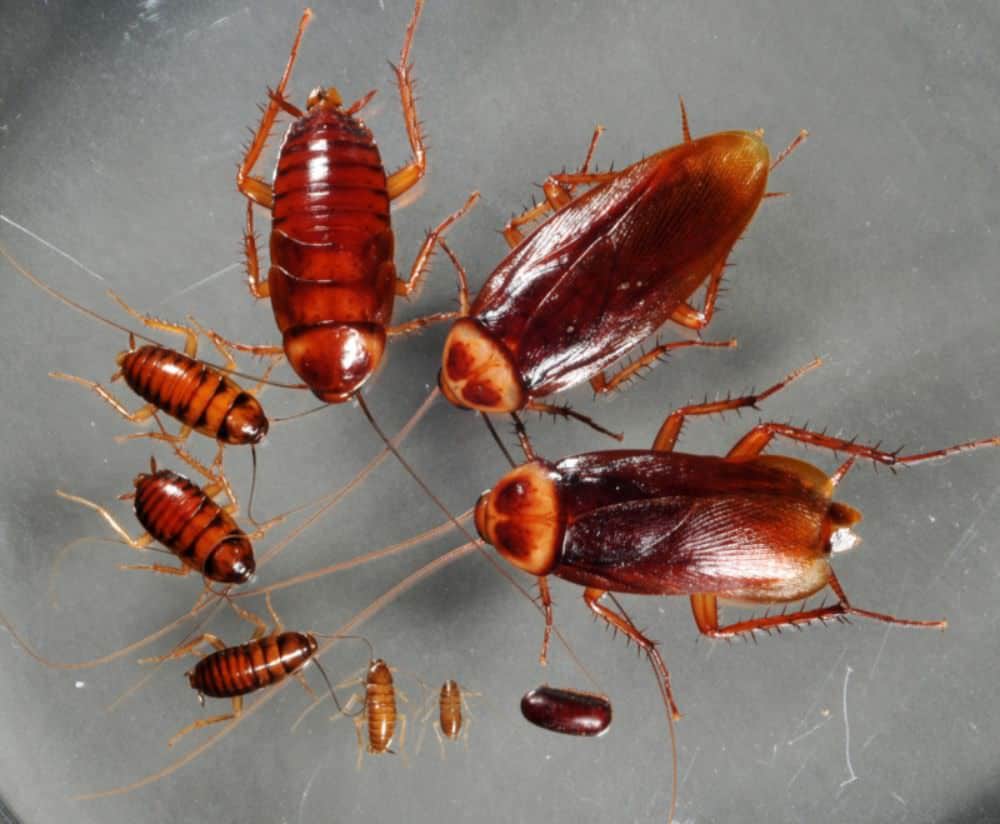
When baby cockroaches first emerge from their eggs case (the ootheca), they are tiny—less than a quarter of an inch long.
Certain species of nymph are altricial, born in an undeveloped state. They are fragile, blind creatures that require parental care during the first stage of life. You are unlikely to see nymphs in this phase, out and about. From there onwards, size depends on the cockroach species.
For example, adult German cockroaches are small insects. They measure in at around half an inch long. This means that the nymphs are significantly smaller than that of other species of roach.
Other breeds, such as the American cockroach, are larger. The adults can grow up to two inches in length. An American cockroach nymph can be larger than a German cockroach adult.
Color
The color of a cockroach nymph can help you determine what species it is. In turn, knowing the species is helpful towards combating the infestation.
When any type of baby cockroach molts, it turns white. For a period of several hours, the nymph must allow its outer layer (cuticle) to harden. As the cuticle hardens, the colors and patterns return.
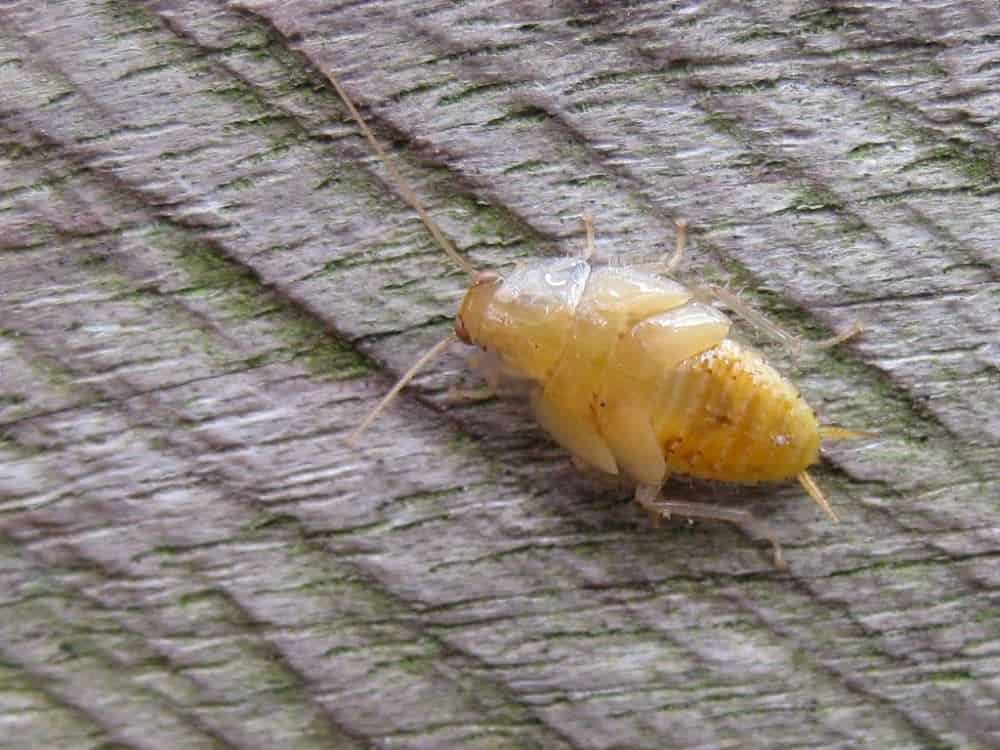
Color patterns on nymphs change as they grow larger. Brown-banded cockroach nymphs are born with the same distinctive brown heads that the adults have.
However, they only show the distinctive brown bands by the second instar. As the nymph molts, the two brown bands appear more clearly.
American cockroach nymphs darken in color as they molt. They begin life as a grayish brown color. After subsequent instars, the nymph will start to turn the same reddish-brown color as the adults.
Shape
Nymphs can pass through a range of shapes as they develop. Some species of nymph may keep the same shape, only growing larger in size. Others eventually develop wings, which can significantly change their appearance on becoming an adult.
The appearance of gender-specific traits will also alter the nymph’s shape. For example, male German cockroaches are slender and slim. The female adults are stout, short and round.
So-called “lobster” cockroach nymphs are shaped differently at every phase. During the first stage, the nymph is egg-shaped and slim. By the third instar, the nymph has a widened posterior. It is only by the fourth development that the nymph’s body becomes slim with ridges.
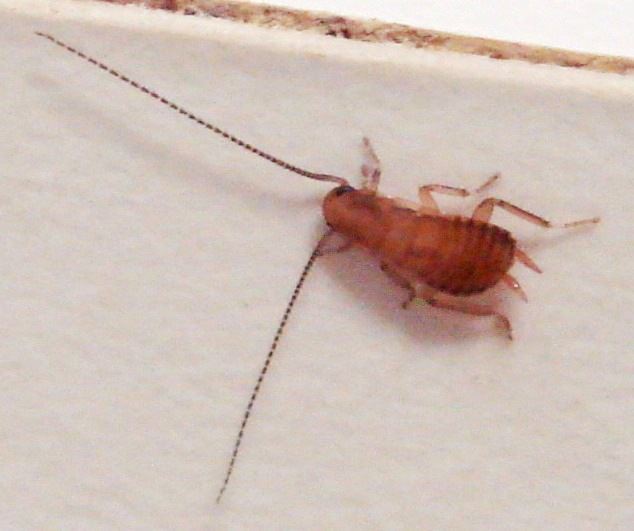
Movement
All species of cockroaches have six legs. The majority of nymphs are able to get around independently right after hatching. The only exceptions are altricial nymphs, which are born blind and delicate.
For winged species, the ability to fly will come with time. Wings do not develop immediately. In many cases, nymphs will not be able to fly until they have reached full adulthood.
Cockroaches have powerful legs. The adults of certain species are capable of running at speeds of up to three miles per hour. Nymphs may not be as fast as the adults, but they are still speedy.
Other species of cockroach are not so fast. Oriental cockroaches are one example. Both nymphs and adults move slower than the average cockroach. Unlike other species, they do not like to climb, preferring to stay at ground level.
Do Baby Cockroaches Bite?
Nymphs have similar diets to adult cockroaches. A cockroach’s diet can vary from species to species. In most cases, cockroaches at any stage will not bite a human.
Unlike other pests such as mosquitoes, they do not feed off blood.
If you have an extreme cockroach infestation, bites can occur, either from nymphs or adult roaches. There have been reports of cockroaches eating food residue off sleeping humans. During these instances, the roach can unintentionally bite the skin.
What Do Baby Cockroaches Eat?
The majority of cockroaches are opportunistic scavengers. Some species that live in tropical environments are vegetarians. The cockroaches that are pests to humans can survive off almost any food type. They will eat whatever they can find in their environments. Most breeds enjoy meat, along with starchy and sweet foods.
Specific types of roach do have favorite food items. Brown-banded cockroach nymphs have a taste for foods with starch in them. This can include starches that are inedible to humans, such as envelope glue.

American cockroach nymphs are attracted to anything that is rotting. This can include meats, vegetables, and processed items. Immature oriental cockroaches share the same fondness for decaying food. They are particularly partial to the contents of tin cans.
Another common nuisance is the German cockroach. The nymphs of this species have many preferred foodstuffs. They can feed off crumbs, meat, and even spots of oil or grease.
Are Baby Cockroaches Dangerous?
It is unlikely that you will be bitten by a baby cockroach. However, the nymphs can cause the same issues as adults. Cockroach saliva and feces can provoke allergies in humans. The molts of cockroach nymphs can do the same.
The nymphs pass through numerous instars on their way to adulthood. Their cast-off exoskeletons remain in the environment. If there are hundreds of cockroach nymphs in your home, this is a lot of molts.
The symptoms of an allergy to cockroaches can vary. You may experience coughing, congestion, or a rash. Other individuals can develop recurring ear and sinus infections.
How Long for Babies to Turn Into Adults?
The time it takes a cockroach nymph to reach adulthood varies with each species; some types take longer than others to mature fully.
All cockroaches follow the same developmental process. They molt and go through instars until they are adults. The number of sheddings and stages also vary, depending on the species.
Factors such as climate and resources can impact development. If the conditions are less than ideal, nymphs take more time to reach adulthood.
I will cover the species that are most relevant to us. These are the cockroaches that are likely to infest public and private properties. These species include German, American, and brown-banded cockroaches.
German Cockroaches
Much like humans, each German cockroach nymph is different. They do not all develop at the same pace. Certain nymphs take fewer molts to reach adulthood than others.
Most nymphs will outgrow their exoskeleton six times. They thrive at room temperature. Under optimal conditions, each peel will span a period of 60 days—roughly two months.
American Cockroaches
American cockroach nymphs take a long time to grow into adults. It takes an average of 600 days—almost two years—for them to become fully grown.
As with German cockroaches, they are not all alike. An American cockroach nymph will go through between six and 14 molts.
Brown-Banded Cockroaches
Brown-banded cockroach nymphs are adaptable to climate. They can mature at temperatures ranging from 77 to 91 degrees Fahrenheit.
However, cold temperatures slow the nymph’s development. It can take from 56 to 217 days for a nymph to fully mature, depending on the environment.
How to Find & Kill Baby Roaches
Getting rid of a cockroach infestation involves tackling the problem in several ways at once. If you do have a serious problem with roaches, it’s likely that the babies will outnumber the adults.
The females lay anywhere between 14 to 40 eggs at a time, depending on the species. Over time, that adds up to a large population of nymphs. In fact, one female brown-banded cockroach can produce over 300 cockroaches per year.
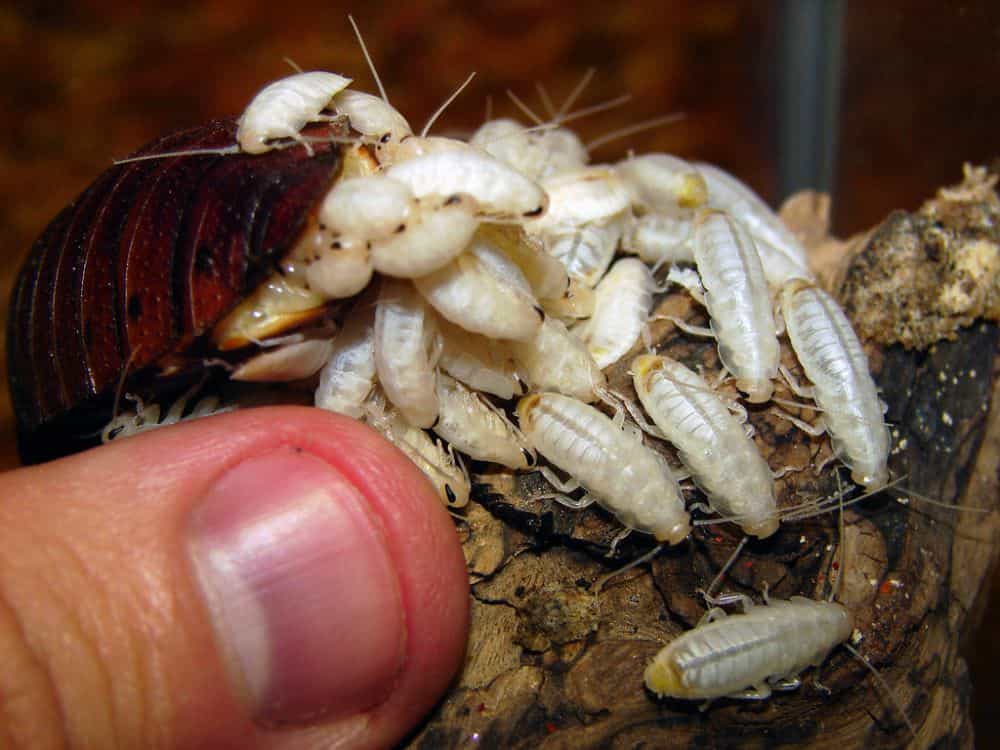
The first step is determining what species of baby cockroach is on your property. This is important because each species has different habitat preferences. Nymphs are partial to the same environments as the adults they grow into.
American cockroaches prefer living in outdoor environments. These roaches and their nymphs enter private homes as visitors. They go into homes to seek shelter and, if available, food.
Contrastingly, German cockroaches need to inhabit areas near humans. Neither the nymphs nor adults can survive in environments without people.
Both American and German cockroaches are climbers. Oriental cockroaches (so-called “water bugs”) are not. As the nickname suggests, Oriental roaches seek out wet areas. This includes damp basements and crawl spaces.
You are likely to find these pests trapped in sinks or bathtubs. This is because they are unable to clamber up smooth surfaces, unlike other roaches.
The majority of cockroaches are skilled hiders. The nymphs avoid exposure unless it is absolutely necessary. To kill the nymphs, you will need to discover all their hiding spots.
Adult German cockroaches can fit themselves in cracks that are far smaller than their bodies. For their nymphs, suitable hiding places are even easier to find. As with the adults, nymphs are attracted to moisture, darkness, and warmth. They will congregate near electrical appliances that generate heat, such as your fridge.
Nymphs also prefer to settle in areas with readily accessible sources of food. This is why kitchens are a frequent spot for cockroach infestations. Neglected trash cans or bags are optimal environments.
Keep in mind that cockroaches are nocturnal insects. Both nymphs and adults are more likely to be active at night, scavenging for food.
Killing baby cockroaches involves preparation. After that, you have the option of using one or more control methods such as insecticides.
Get Rid of Resources
To control a cockroach infestation, you first have to remove their resources. These consist mainly of food and water. Even if you get rid of nymphs and adults, more can follow. This is more likely to happen if there are readily available resources.
It is difficult to starve a baby cockroach. Even small drops of water or scattered crumbs are enough for their continued survival.
Still, you can limit access to larger resources. Do not leave unsealed food containers or open packets out in your kitchen. Instead, use airtight containers that the nymphs and roaches cannot penetrate.
Keep trash containers tightly sealed. Do not overfill trash cans or bags, and remove them frequently. Cockroaches prefer environments that are messy. Not only do they have more opportunities to hide, but there is more debris to feed off.
Keep your kitchen as clean and tidy as possible. If you are preparing food, wipe down counters and other surfaces after you are finished.
A thorough cleaning is necessary if you are fighting cockroaches. Vacuum your floors and furniture regularly to get rid of crumbs and also—possibly—cockroach eggs. Throw away any refuse, such as chip packets, soda cans, and empty tins, as soon as possible.
Leaking pipes or taps need to be repaired. If there is anywhere else where water collects, solve the issue. You do not want to give the baby cockroaches free access to water.
Don’t allow trash to gather outside your property. Keep outdoor trash containers at a distance from your home.
Getting Rid of Hiding Places
Non-organic mess, for example, cardboard boxes, can worsen a cockroach infestation. As I mentioned earlier, brown-banded cockroaches can eat paper glue.
This is not the only reason why you should get rid of these unneeded items. Remember that cockroaches don’t like to be out in the open; an empty box is a perfect hiding place.
Piles of rags, bags or any other objects serve as protection for the nymphs. They can move around your home without fear of exposure. After all, if you spot a baby cockroach you are likely to kill it upon sight.
If the cockroaches can move unseen, you are at a disadvantage. If possible, get rid of these hiding places entirely. Throw any unnecessary items that could be hiding places.
Go through storage areas to ensure no nymphs are hiding. Even rolled up carpets can serve as a safe haven for an immature cockroach.
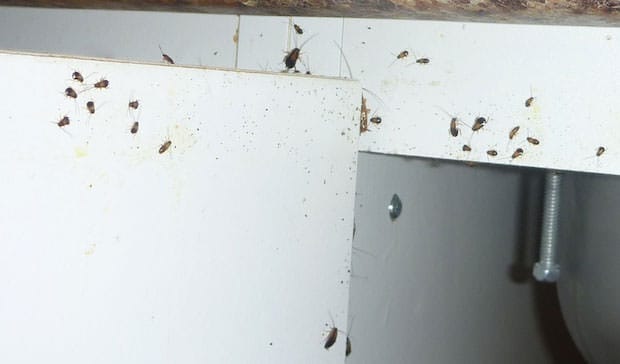
Once you have dealt with superficial hiding spots, it is time to go deeper. Cracks in furniture can be hotspots for baby cockroaches. Ensure such locations are clear of roaches and seal them off.
If there are cracks in your flooring or walls, seal these too. Babies, as well as adult roaches, can live inside hollow walls. You want to be sure all the roaches are dead before sealing such areas. At the very least, you should guarantee that they cannot escape into your home.
Baits
Baits contain insecticides that kill the target insect following contact. Cockroach baits include a food-like base that will entice the cockroach. Once ingested, the cockroach will die—this usually takes a few days, depending on the method.
Take note that baits do not attract cockroaches if other sources of food are available in the vicinity, so placement is important.
Baits are effective on adult and immature cockroaches, except for egg-bearing females. They eat infrequently and do not venture out of hiding often.
These pesticides are frequently used to deal with cockroach infestations. Cockroach baits can come in different forms. They can be dust, gels, granules or pastes. Do not use baits before you have eliminated other food sources.
Set cockroach baits in locations cockroaches are likely to come across them. For example, place baits near suspected hiding places, in the corners of your home or beside trash cans.
Without easily accessible food sources, the nymphs will emerge to forage for food. This is when they will come across the baits. If you have pets or children, you can purchase bait stations, where the insecticide is placed inside a secure plastic unit.
Select the form that best suits your situation. For example, gels or pastes may be the best solution if you have irreparable cracks in your walls. Placing the bait in these cracks means the baby roaches will have to pass them at some point.
Baits do not kill their victims immediately. One infected cockroach can kill up to 40 more. When a roach eats the bait it will then return to its hiding place, where the poison is transferred to others and will also poison them. After the poisoned roach dies, others may eat the remains and, subsequently, also be poisoned.
When handling any pesticide, follow product guidelines exactly. Do not set unprotected baits in locations pets and children have access to.
Boric Acid
Boric acid is a pesticide that is usually available as a dust. It can kill cockroach nymphs in one of two ways. If eaten, boric acid destroys a cockroach’s nervous system. If the dust sticks to the roach, it can damage the roach’s tough exoskeleton.
This pesticide is a useful long-term measure against cockroaches. If boric acid is kept dry, it can remain effective for lengthy periods of time.
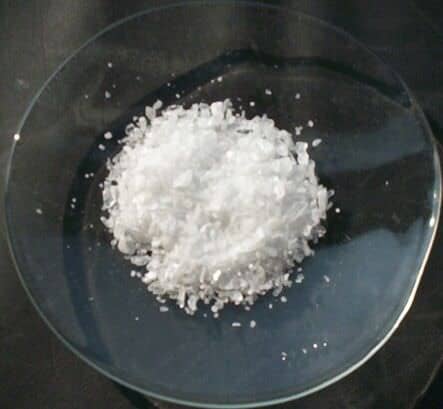
Boric acid dust should not be applied to surfaces that you come in contact with. This pesticide does not disappear unless it is washed away. Instead, you can leave dust in crevices, cracks, and in corners.
Do not neglect the areas underneath appliances and furniture. You can use boric acid dust behind your stove, sink, and refrigerator.
Always take into account your family members when using this boric acid. Do not leave dust anywhere that your children or pets could come into contact with it. Take appropriate precautions. Take care not to inhale the dust during application. Follow product guidelines exactly—do not apply more pesticide than indicated.
Insect Growth Regulators (IGRs)
Insect growth regulators (IGRs) are a unique category of insecticide. These do not kill targeted insects as other chemicals do. Rather, IGRs interrupt reproduction cycles and development. These pesticides come in plastic stations or as sprays.
Baby cockroaches begin to produce hormones as they mature. These hormones allow the cockroach nymph to develop into a functional adult. IGR’s contain chemicals that mimic these hormones. If a cockroach nymph is exposed to an IGR, it will interfere with normal development.
Every cockroach nymph enters one final instar before it molts into a fully-fledged adult. IGRs disrupt this last instar. Instead of a normal adult, the nymph will molt into a sterile adult. Winged cockroaches will suffer from deformed wings, preventing them from flying.
As with baits and boric acid, IGRs are not instantly effective. The cockroach population will only decline when sterile adults outnumber normal ones. For this reason, IGRs are best used in combination with other cockroach control methods.
Insecticide Sprays
Sprays and aerosols are a last resort option for severe infestations. These are the most toxic option for controlling cockroaches.
Certain chemicals will kill the roaches on contact. Other types will only repel them. In the latter case, both baby and adult cockroaches will simply avoid sprayed areas.
These insecticides tend to leave a residue. In some cases, you and your family will have to evacuate your home when they are applied.
Some commercially available insecticides are for contact-kills only. If your home is badly infested, you may often see cockroaches scurrying about in the open. You can directly spray any nymphs or adults you see.
Ongoing Maintenance
If you do not want a repeat infestation, stay vigilant. Do not allow your home to become unkempt. A dirty or messy environment is the ideal habitat for cockroaches of all ages.
If none of these approaches work, you should seek professional help. An exterminator can work with you to get rid of cockroaches in your home.
Summary
Now you know how to identify and kill baby cockroaches. If you suspect an infestation, take action immediately. Cockroaches are prolific breeders and infestations can worsen rapidly.
Remember that an integrated approach is best. You want to make sure that the adults, as well as the baby cockroaches, are eliminated. More importantly, you do not want the cockroaches to return. Keep your home clean both indoors and outdoors.

